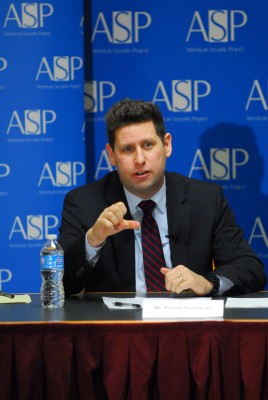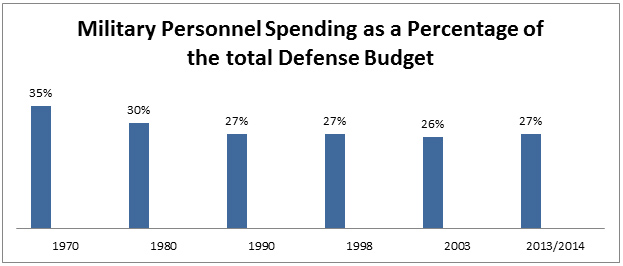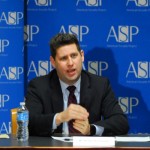
Event Recap: Defense Budget in 2014: A Conversation with Russell Rumbaugh
Podcast: Play in new window | Download
Subscribe: Apple Podcasts | RSS
 On Thursday, January 30th, ASP hosted Russell Rumbaugh, a senior associate at the Stimson Center and Director of its Budgeting for Foreign Affairs and Defense program. He discussed the defense budget for fiscal year 2014 with ASP’s CEO Brigadier General Steve Cheney, along with numerous guests.
On Thursday, January 30th, ASP hosted Russell Rumbaugh, a senior associate at the Stimson Center and Director of its Budgeting for Foreign Affairs and Defense program. He discussed the defense budget for fiscal year 2014 with ASP’s CEO Brigadier General Steve Cheney, along with numerous guests.
To open up, Cheney stated that, “one of our thoughts here at the American Security Project is that the budget is not always tailored to what our strategy is, and we think that it ought to be.”
In response, Rumbaugh talked about the importance of having these types of conversations together, and that by examining the different areas of the budget, we can figure out what people are saying it is doing, what we think it is doing, and how we can make it better.
“I think you can learn a lot from looking at the budgets, and they do matter to how we figure out what U.S policy is, both within the U.S. and abroad.” – Rumbaugh
He goes on to talk about that during the process of formulating the budget, there is a lot of “skewing” that takes place. “This is what leads to the difficulty of understanding what is going on with the budget and what the strategy is going to be.”
Rumbaugh believes that if the bipartisan budget act holds, and if the caps that are in place hold, the United States is going to settle out at significantly higher defense spending than any of the past defense budgets. His estimates are that the defense budget will be around 480 billion as the low-point, which is 25% higher than the downturns we went through during the 50s, 70s, and the 90s; not to mention that this was during the Cold War.
Speaking in constant dollars, Rumbaugh explained:
“In the 50s, the lowest point of the defense budget was 373 billion, the 70s: 384 billion; and the nineties: 391 billion. None broke 400 billion. That seems pretty dramatic that while drawing the defense budget down, we are going to land at a spot a quarter higher than we used to land.” – Rumbaugh
However, he makes the point that this is not counting war costs, which is a separate budget within itself that does not count against spending caps. Although the war budget may go away when troops draw down from Afghanistan, it is unlikely since the U.S. has had a war budget since the Gulf War of 1991.
“If you add the war budget on top, we are looking at 50% above what our defense budgets were in the 50s, 70s, and 90s. Is this the post-Cold War world? Is this the War on Terrorism world? Is there a structural change and is there a strategic or geopolitical reason, or do we need to start sniffing around for more suspicious skewing reasons of why it is higher?” – Rumbaugh
So what’s in the defense budget?
Rumbaugh says that the first take-away has to be that this is “kind of a healthy defense budget.” What does healthy mean you might ask? –The term “healthy” refers to the current readiness of our military force. Readiness includes all military operations, maintenance, training, and people costs, such as travel. The ability to send our troops anywhere in the world at any given time is considered “readiness”.
He talks about how there is no question that personnel are the basis of all American military achievements. However, he goes on to say that “Military personnel spending as an aggregate has not changed that much.”
According to Rumbaugh, these numbers mean that military personnel are not consuming the defense budget. However, we have a lot less people. We used to keep about 3 million people in uniform in the eighties, but now we have just above 1.2 million. Each individual is becoming more expensive, but we have less people so it still balances out to around 27%.
One of his final remarks regarding spending caps explains how they put all of the defense dollars in competition with one another. For example, outside of the Department of Defense is nuclear weapons spending, which is handled by the Department of Energy. Fiscal Year 2014 Omnibus included two billion more dollars than post-sequester Fiscal Year 2013. One billion dollars went to the National Nuclear Security Administration’s weapon activities, which includes the stockpiling and maintenance of nuclear warheads.
“That’s 50% of our slight increase in FY ’14. Half is going to one account, which only includes 7 billion dollars, so 1 billion dollars is a big swing. That means we are taking away dollars from everything else in defense. Are we really going to move forward in modernizing the nuclear triad, even as we are unsure as to what our nuclear strategy should be? Is this really where we need to be spending our money?”– Rumbaugh
According to Rumbaugh, Former Air Force Chief of Staff, Gen. Norton Scwhartz does not think so. However, you can read more about that in – Benefit or Burden? The Future of U.S. Tactical Nuclear Weapons.
In closing, Rumbaugh raises numerous questions: “Where are we putting any marginal dollars; conventional capabilities, nuclear capabilities, personnel, readiness, modernization? Those are the questions we face as we answer the strategy question. There’s no doubt our defense budget and defense forces are going to get smaller, but it will be a “large small”, as well as a healthy small.”
Nathan Daniels is a Research Assistant & Intern at the American Security Project covering nuclear security issues.
You can listen to or watch the event here:















[…] via Defense Budget in 2014 – Event Recap | American Security Project. […]
[…] Defense Budget in 2014: A Conversation with Russell Rumbaugh – Event Recap Nathan Daniels […]